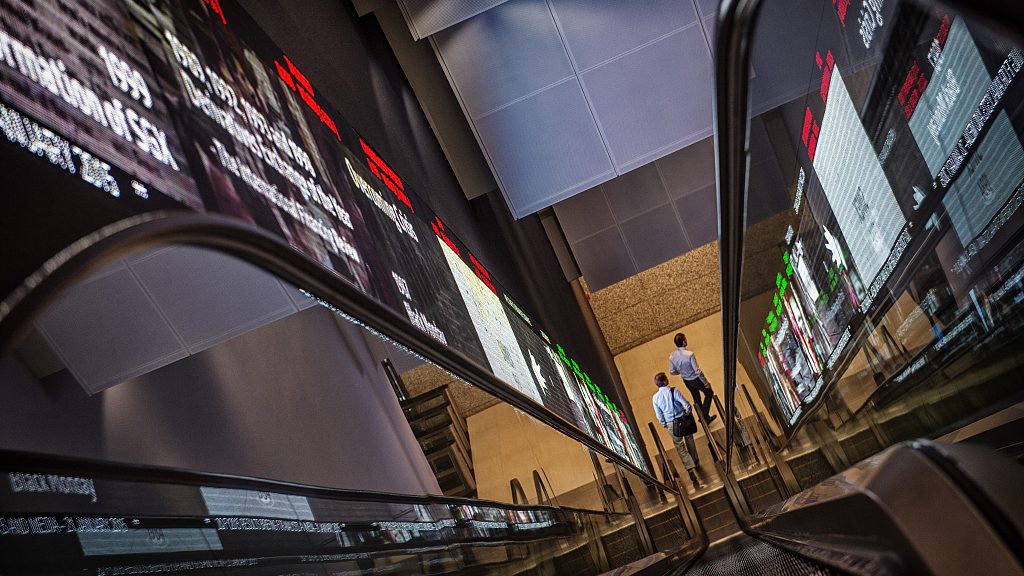
Pedestrians exit an escalator at the Singapore Exchange headquarters in Singapore, January 21, 2015. /CFP
Pedestrians exit an escalator at the Singapore Exchange headquarters in Singapore, January 21, 2015. /CFP
Editor's note: Matteo Giovannini is a finance professional at the Industrial and Commercial Bank of China in Beijing and a member of the China Task Force at the Italian Ministry of Economic Development. The article reflects the author's views, and not necessarily those of CGTN.
Over the last decade, the frequency of discussions at the level of state cabinets and corporate boards of strategies for financing the transition to a sustainable global economy has been directly proportional to the growing environmental concern caused by the effects of climate change.
In this time span, the sustainable finance ecosystem across equity capital markets, bonds, and loans has seen an unprecedented surge with a global market that has increased a hundredfold from $5.2 billion in 2012 to more than $540 billion in 2021.
China and Singapore publicly announced to have reached a series of important agreements at the 18th Joint Council for Bilateral Cooperation, an annual top-level meeting, on November 1. It deepens mutual support in areas ranging from green financing to digitalization and innovation.
According to a press release from the Monetary Authority of Singapore, new initiatives aimed at expanding green finance cooperation and at increasing the level of linkage with China include a Green Finance Taskforce, an Exchange Traded Funds (ETF) Product Link, and a Low Carbon Index Family.
The first consideration to make here is that the launch of a Green Finance Taskforce not only underlines the critical role played by finance in mobilizing resources to facilitate a historical energy transition but also build up on earlier initiatives between China and Singapore aimed at promoting capital market connectivity and internationalization of the Chinese yuan.
The launch on the Singapore Exchange of the largest ETF to invest exclusively in Chinese government bonds in September 2020 and the establishment of an ETF Product Link between the Singapore Exchange and Shenzhen Stock Exchange at the 17th China-Singapore Joint Council for Bilateral Cooperation Meeting last year are good examples that set the conditions for this year's announcement.
One of the main purposes of the Taskforce, while deepening bilateral cooperation in the green finance sector, is to promote a stronger public-private partnership where governments would benefit from the contribution of technological and innovation expertise from the private sector. Accordingly, an increased mobilization of private capital is set to play a key role in bridging the funding gap in the region and in expanding the vision of a prosperous, inclusive, and sustainable Asia.
From a capital markets' perspective, the increased connectivity combines Singapore's reputation as a leading global financial center and tech innovation hub with the Chinese mainland's rising stock exchanges. Beijing, Shanghai, and Shenzhen Stock Exchanges could gain access to the expertise of one of the world's most advanced and dynamic economies, increasing cross-border circulation of financial instruments.
The launch by year-end of the first three participating ETFs under the ETF Product Link on the Singapore Exchange and Shenzhen Stock Exchange and the inauguration of a Low Carbon Index Family on the two stock exchanges will lay the foundation for a surge in reciprocal investment opportunities and channel capitals toward sustainable businesses, respectively.

A view of Ant Sustainability Development Showroom at the financial services exhibition of the 2022 China International Fair for Trade in Services, in Beijing, China, September 1, 2022. /CFP
A view of Ant Sustainability Development Showroom at the financial services exhibition of the 2022 China International Fair for Trade in Services, in Beijing, China, September 1, 2022. /CFP
Hong Kong Special Administrative Region, as an international financial center that is uniquely connected with the Chinese mainland and the rest of the world, can also be a part of the equation. Hong Kong is one of the largest and most vibrant green and sustainable finance markets in Asia. Last year, a third of Asian international green bond issuances were arranged in Hong Kong, making it the top issuance center of such financial instruments.
From a geopolitical perspective, the bilateral cooperation between China and Singapore demonstrates that Asia is rapidly becoming a more mature region that can work out solutions to tackle urgent global challenges without the necessity to rely on Western capital markets and technology as was the case in the past.
All things considered, an increased level of connectivity with Singapore not only demonstrates China's willingness to become a more prominent player in the global financial arena but also shows the country's readiness to take on responsibility to lead the way for the transition to a greener future.
At a time when market disruption is intensifying and when climate change represents a major threat to the natural environment and international security, initiatives aimed at joining forces toward a common goal should be praised.
(If you want to contribute and have specific expertise, please contact us at opinions@cgtn.com. Follow @thouse_opinions on Twitter to discover the latest commentaries in the CGTN Opinion Section.)